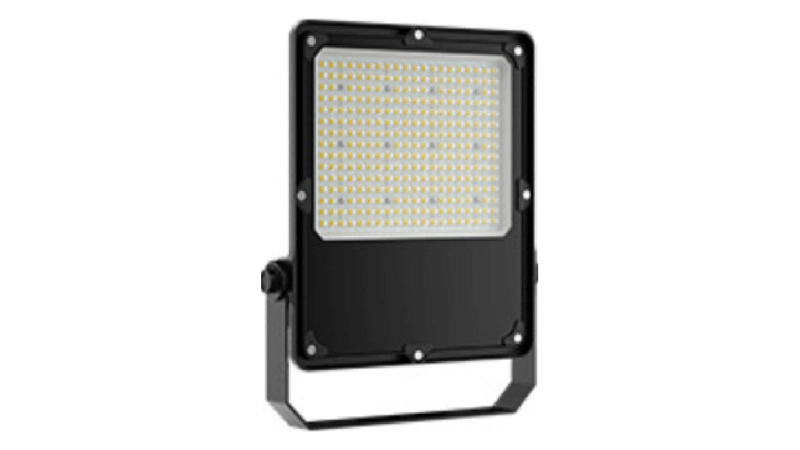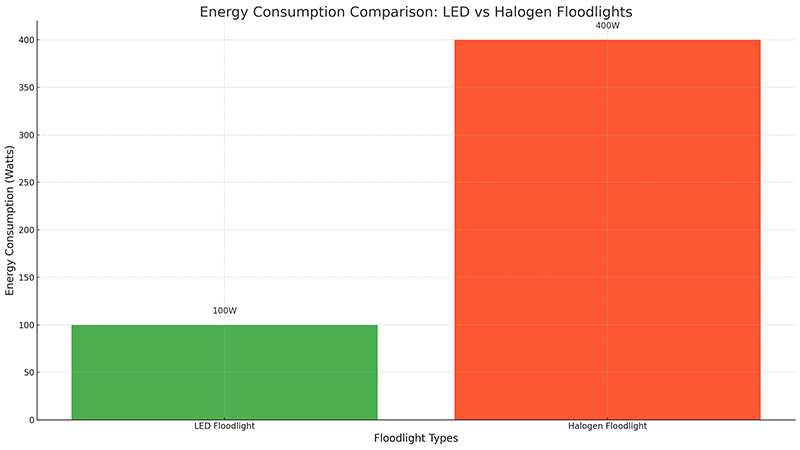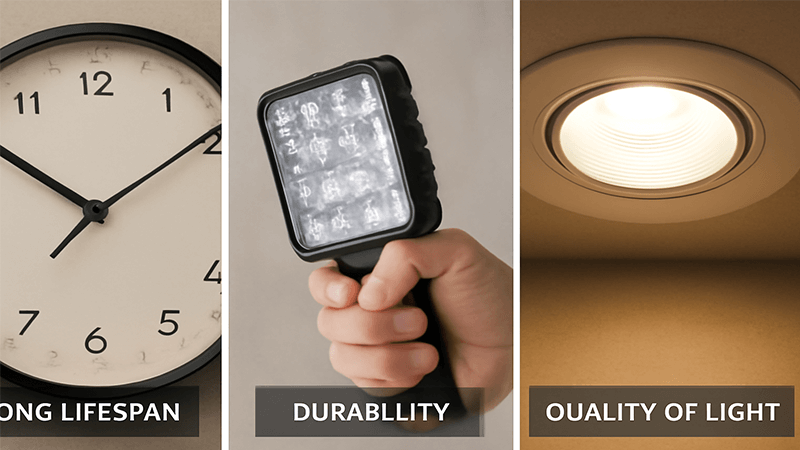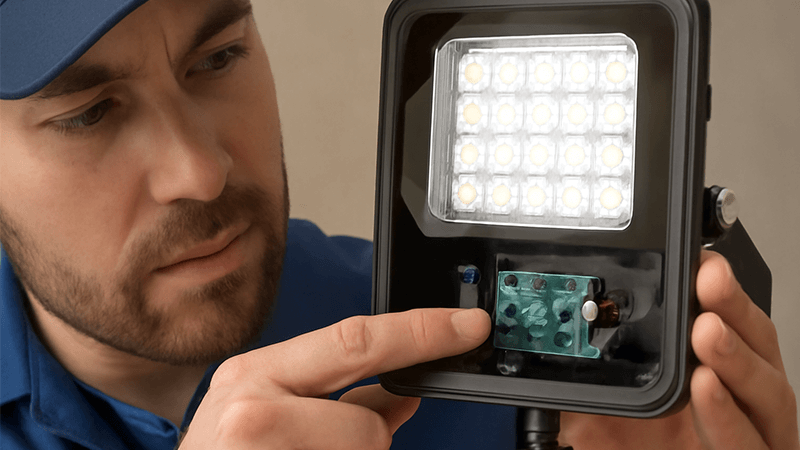High electricity bills from traditional floodlights are a constant budget drain. This outdated tech wastes energy and money, making it hard to compete. LED floodlights offer a powerful way to save.
Yes, LED floodlights are the top choice for energy efficiency. They use up to 80% less energy than traditional lights like halogen or metal halide. This means significant, immediate cost savings on your electricity bills and a lower total cost of ownership over the project’s lifetime.

So, we know LEDs save energy. But how do they do it, and what other benefits matter for your projects? I’ve spent years in this industry, and I know that understanding the technology helps you make better purchasing decisions. Let’s look at the specifics.
Are LED flood lights energy efficient?
You’re always trying to reduce project costs. Traditional lighting is a major energy drain, inflating expenses. LED floodlights directly address this by using far less power for the same brightness.
Absolutely. LED floodlights are extremely energy-efficient. They convert about 95% of energy into light, wasting very little as heat. This is a huge improvement over old bulbs that are mostly heaters that glow, which means you get massive savings on your electricity bills.

The best way to measure lighting efficiency is to look at a metric called "lumens per watt" (lm/W). Think of it like "miles per gallon" for a car. It tells you how much light (lumens) you get for each unit of energy (watt) you put in. A higher number is better. From my experience on the factory floor, I can tell you that this single number is one of the most important specifications when you’re sourcing lights. A high-quality LED floodlight can have an efficacy of 130 lm/W or even higher. Compare that to an old halogen bulb, which is often around 15-20 lm/W. The difference is huge. A lot of that wasted energy in a halogen bulb is lost as heat. If you’ve ever stood near one, you know how hot they get. This not only wastes electricity but can also increase cooling costs if the lights are used in or near climate-controlled spaces. I once worked with a client managing a large logistics warehouse. They switched their old 400-watt metal halide fixtures to 150-watt LED high bays. Their monthly electricity bill for lighting dropped by over 60%. That kind of savings goes directly to the bottom line, making the initial investment pay for itself very quickly.
Lighting Technology Efficiency Comparison
| Feature |
LED Floodlight |
Halogen Floodlight |
Metal Halide |
| Typical Efficiency (lm/W) |
120 – 170 lm/W |
15 – 25 lm/W |
75 – 100 lm/W |
| Energy Wasted as Heat |
~5% |
~90% |
~75% |
| Average Lifespan |
50,000+ hours |
2,000 hours |
15,000 hours |
| Typical Payback Period |
1-3 Years |
N/A |
N/A |
This table makes it clear. You are not just buying a light; you are investing in an energy-saving system that delivers better performance for years. The numbers speak for themselves.
How do LED lights improve energy efficiency?
You know LEDs are efficient, but you’re not sure why. Without understanding the technology, it’s hard to justify the investment. I will explain the simple science behind their performance.
LEDs improve energy efficiency with their solid-state technology. Instead of heating a filament, LEDs create light by passing current through a semiconductor. This process is called electroluminescence. It generates very little heat, maximizing light output from every watt of electricity used.

At the heart of an LED is a small chip, a semiconductor. When you pass a controlled electrical current through this material, it excites electrons, and they release energy in the form of photons, which is light. This whole process is called electroluminescence. It’s a direct conversion of electricity into light at a very small scale. Unlike old-fashioned bulbs, there is no filament to heat until it glows white-hot. That heating process is incredibly wasteful. Heat is the biggest enemy of energy efficiency in lighting. With incandescent and halogen bulbs, you are essentially paying to run a small heater that happens to produce some light as a side effect.
The Key Components of Efficiency
Three main parts work together to make an LED fixture efficient.
- The LED Chip: The quality of the semiconductor material directly impacts how efficiently it converts electricity into light. Top-tier manufacturers produce chips that create more lumens with less energy and less heat.
- The LED Driver: This is the electronic power supply for the LED. It converts the AC power from the wall into the low-voltage DC power the LED chip needs. A high-quality driver does this conversion very efficiently, with minimal energy loss. A cheap, inefficient driver can waste energy and also cause the whole fixture to fail early.
- The Optics (Lens/Reflector): This is where a lot of innovation happens. Once the light is created, you need to direct it where it’s needed. Advanced lenses and reflectors can shape the light beam precisely onto a building, a parking lot, or a field. This prevents light from spilling into the sky or other places where it’s not wanted. No wasted light means no wasted energy. This precise control is something older technologies just can’t match.
What are three advantages of LED lights?
Energy savings are great, but you need more reasons to switch. Focusing only on cost means you miss other huge benefits. LEDs offer major advantages in lifespan, durability, and light quality.
Beyond energy savings, the three main advantages are their very long lifespan (up to 50,000+ hours), great durability from their solid-state design, and better light quality. This means fewer replacements, tougher fixtures, and improved visibility and safety for your projects.

When I talk to purchasing managers like Shaz, we always discuss the total cost of ownership, not just the upfront price. The real value of LEDs comes from these three key areas, which reduce costs and improve operations for years after the initial purchase. Energy efficiency is just the beginning of the story.
Advantage 1: Unmatched Lifespan
An LED floodlight is often rated for 50,000 hours or more. A traditional halogen bulb might last 2,000 hours. This means you would have to buy and replace the halogen bulb 25 times to match the lifespan of a single LED fixture. Think about the costs involved. It’s not just the price of the 25 bulbs. It’s the labor cost for a maintenance worker to change them each time. If the fixture is in a hard-to-reach place, like on a tall pole or the side of a multi-story building, you might also need to rent a lift. These maintenance costs add up quickly and can easily exceed the original cost of the fixture itself. With LEDs, you install them and can practically forget about them for a decade or more.
Advantage 2: Built to Last
LEDs are a solid-state technology. There are no fragile filaments to break or delicate glass tubes to shatter. The light-emitting chip is a solid piece of material, usually encased in durable resin and housed in a robust metal casing. This makes them incredibly resistant to shock, vibration, and impact. This is a huge benefit for applications in industrial settings, on construction sites, or near high-traffic roads where vibrations are constant. Traditional bulbs would fail quickly in these environments, but LEDs can handle the tough conditions.
Advantage 3: Superior Light Quality
LEDs give you incredible control over the light itself. You can choose the exact color temperature (CCT), from a warm, inviting light to a crisp, cool daylight. You can also get LEDs with a high Color Rendering Index (CRI), which means colors under the light look true and natural, which is important for security cameras and general safety. Additionally, LEDs are "instant-on." They reach 100% brightness the moment you flip the switch. Metal halide lamps, by contrast, can take several minutes to warm up to full brightness, which is a major inconvenience and a safety issue.
What fails in LED lights?
You’ve heard that even "long-lasting" LEDs can fail too soon. A bad batch of lights can ruin your project’s timeline and budget. Understanding common failure points helps you choose quality.
The most common failure points aren’t the LED chips themselves. It’s usually the supporting components. The LED driver, which regulates power, is a frequent issue. Poor heat management and degrading optical components like lenses also cause premature failure and poor performance over time.

In all my years manufacturing lights, I can tell you that a high-quality LED chip from a reputable brand will almost never fail on its own. It’s the system around the chip that determines the fixture’s true lifespan and reliability. When a client comes to me with a story about LEDs that failed after only a year or two, it’s almost always due to one of these three issues. Knowing what to look for can save you from making a costly mistake.
The Critical Role of the LED Driver
The driver is the heart of the fixture. It’s a complex piece of electronics that manages the power going to the LEDs. A cheap driver will use low-quality components like capacitors that can’t handle heat or voltage fluctuations. Over time, these components break down, causing the light to flicker or fail completely. This is the single most common point of failure I see in low-cost LED products. A good manufacturer will use drivers from reputable brands and ensure they are properly protected from heat and moisture.
The Silent Killer: Heat Management
While LEDs are efficient, they do produce some heat. This heat must be drawn away from the LED chip. If it isn’t, the high temperature will cause the chip’s light output to decrease permanently over time—a process called lumen depreciation. It also shortens the life of both the chip and the driver. The quality of a fixture’s heatsink is critical. A good heatsink is made from high-grade aluminum with a design that maximizes surface area to effectively dissipate heat into the air. A poorly designed fixture might look good on the outside, but if it traps heat, its performance will suffer dramatically.
Optical Component Degradation
This is a detail that often gets overlooked. The lens in front of the LEDs is crucial for directing light and protecting the chips. My experience has taught me that the material matters. Low-cost fixtures often use cheap plastic lenses. Over time, exposure to sunlight will cause these lenses to turn yellow because they lack a proper anti-UV coating. This yellowing blocks a significant amount of light and can alter the light’s color temperature. A quality fixture will use polycarbonate (PC) or glass lenses with a protective UV coating to ensure long-term stability. Furthermore, the optical uniformity of the lens design is key. A well-designed lens distributes light evenly, preventing hot spots and dark areas. This creates a safer and more visually comfortable environment.
Conclusion
Switching to quality LED floodlights saves energy, time, and money. By understanding what makes them fail, you can choose reliable products for long-term performance and real value.